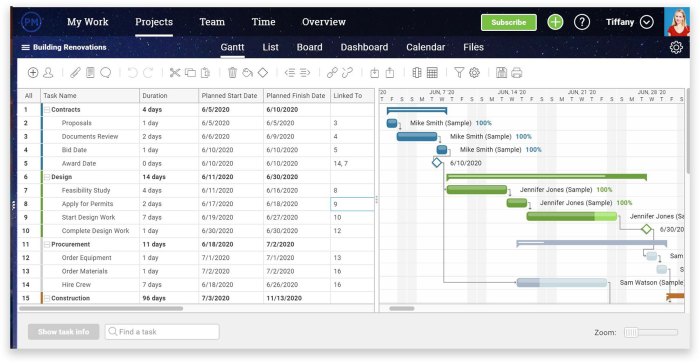Project management scheduling software is revolutionizing how we approach project execution. Imagine a world where deadlines are met consistently, resources are optimized flawlessly, and teams collaborate seamlessly. This isn’t a futuristic fantasy; it’s the reality offered by sophisticated project management scheduling software.
These powerful tools leverage diverse methodologies like Gantt charts, Kanban, and Scrum, empowering teams to visualize progress, manage tasks efficiently, and ultimately achieve project goals with unprecedented precision and speed. This exploration delves into the core functionalities, benefits, and future trends shaping this dynamic field.
From its fundamental features to its advanced capabilities, project management scheduling software empowers individuals and organizations to navigate the complexities of project management with confidence. Understanding the different types of software available, their unique strengths, and how to effectively integrate them into existing workflows is crucial for maximizing efficiency and achieving optimal results.
This guide serves as a comprehensive resource, offering insights into selecting, implementing, and utilizing these powerful tools to unlock your project’s full potential.
Defining Project Management Scheduling Software

Project management scheduling software is your secret weapon for conquering even the most complex projects. It’s essentially a digital toolbox packed with features designed to help you plan, organize, and execute projects efficiently, keeping everything on track and within budget.
Think of it as a central hub for all your project-related information, streamlining communication and collaboration amongst your team.Project management scheduling software offers a range of core functionalities aimed at improving project efficiency and success. These include task management, resource allocation, timeline visualization, progress tracking, and reporting capabilities.
By centralizing these functions, the software significantly reduces the administrative burden associated with project management, allowing teams to focus on delivering value.
Scheduling Methodologies Supported, Project management scheduling software
Different projects require different approaches. Therefore, effective project management scheduling software supports various scheduling methodologies to cater to diverse project needs and team preferences. Three prominent examples are Gantt charts, Kanban, and Scrum. Gantt charts provide a visual representation of a project’s timeline, showing tasks, dependencies, and durations.
Kanban employs a visual workflow management system, focusing on visualizing work and limiting work in progress. Scrum, a framework for agile software development, utilizes short iterative cycles (sprints) to deliver incremental value. The choice of methodology depends on the project’s complexity, team size, and desired level of flexibility.
Common Features of Project Management Scheduling Software
A wealth of features contributes to the effectiveness of this type of software. Many programs offer customizable dashboards providing a personalized overview of key project metrics. Real-time collaboration features facilitate seamless communication and teamwork. Automated reporting tools generate insightful data for tracking progress, identifying bottlenecks, and making informed decisions.
Integration with other business applications, such as email and calendar programs, enhances workflow efficiency. Finally, robust security measures protect sensitive project data. For example, Asana’s collaboration features allow for seamless task assignment and real-time updates, while Monday.com offers customizable dashboards that cater to individual user preferences.
Comparison of Project Management Scheduling Software
| Software | Key Features | Pricing | Best For |
|---|---|---|---|
| Asana | Task management, collaboration tools, Gantt charts, Kanban boards, reporting | Free plan available, paid plans starting at $10.99/user/month | Teams of all sizes, particularly those prioritizing collaboration and task management |
| Monday.com | Highly customizable workflows, automation features, diverse view options (Kanban, calendar, timeline), integrations | Free plan available, paid plans starting at $8/user/month | Teams needing highly adaptable workflows and automation capabilities |
| Trello | Kanban-style boards, simple task management, collaboration features, integrations | Free plan available, paid plans starting at $5/user/month | Smaller teams and projects that benefit from a visual, Kanban-based approach |
End of Discussion
Embracing project management scheduling software is not merely about adopting a new tool; it’s about embracing a transformative approach to project management. By harnessing the power of visualization, collaboration, and data-driven insights, organizations can streamline operations, enhance team communication, and significantly reduce project risks.
As technology continues to evolve, so too will the capabilities of this software, promising even greater efficiency and precision in the years to come. The journey to project success starts with a strategic understanding and effective implementation of these powerful tools – a journey we hope this exploration has illuminated.
